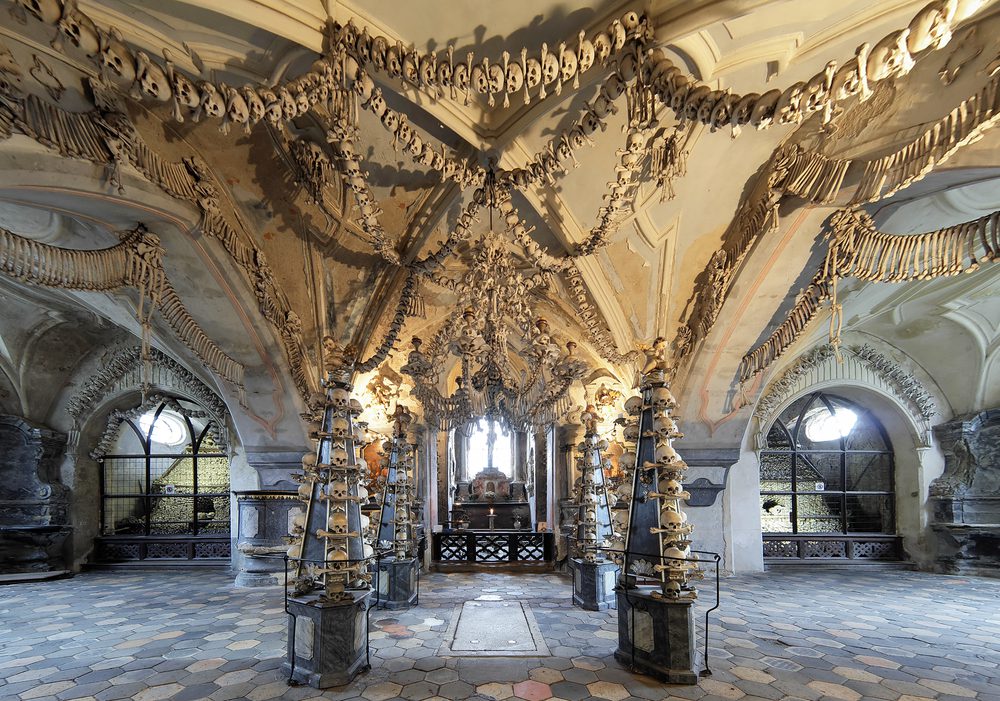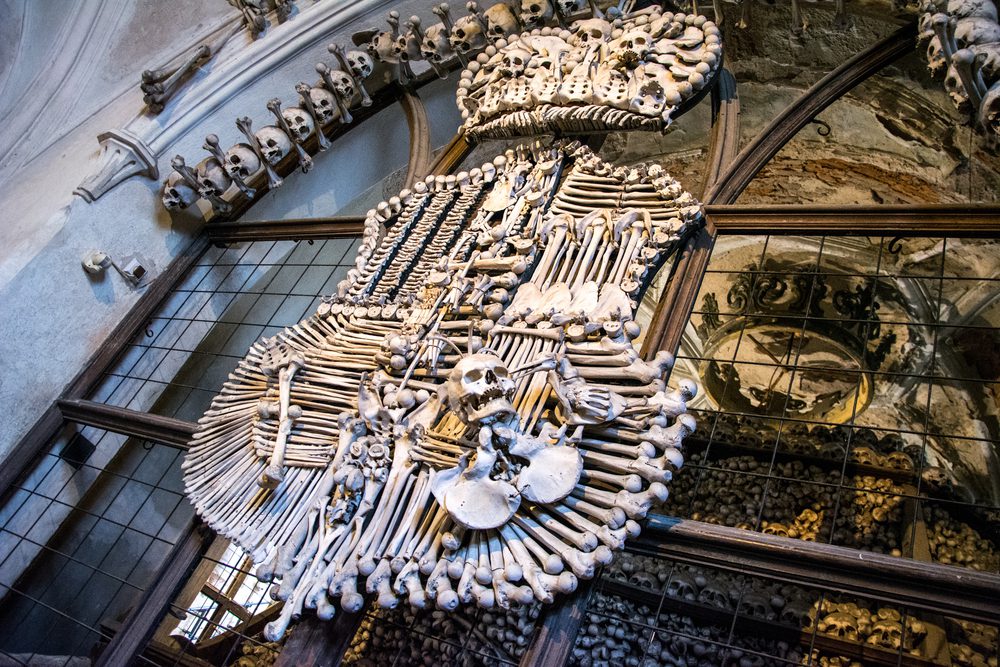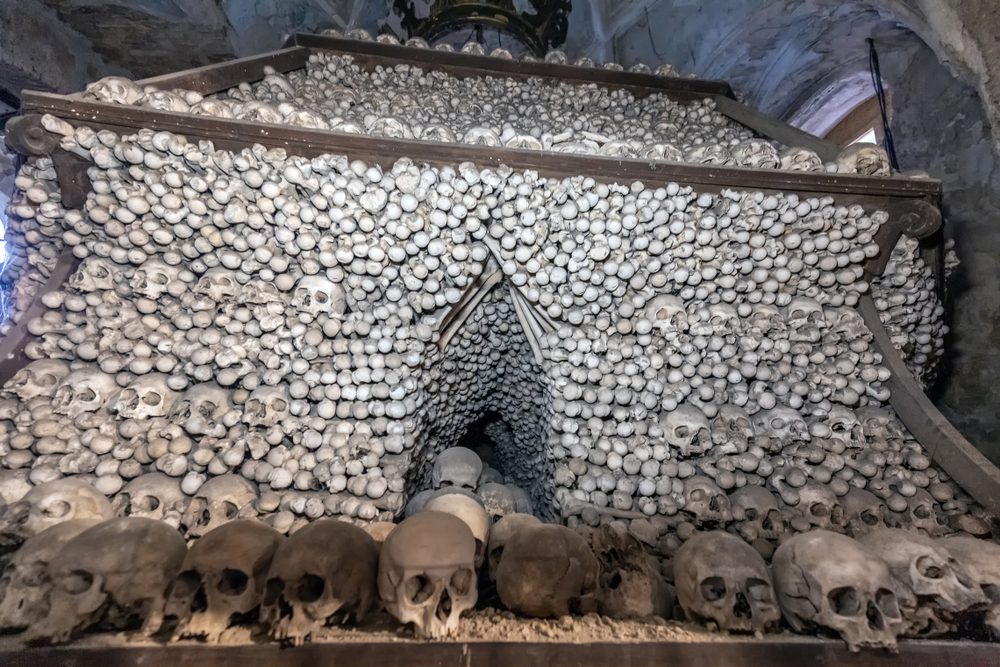From the outside, the Cemetery Church of All Saints in Czechia looks like a quaint but unassuming church perched on top of a graveyard. But beneath this Gothic building, you’ll find the final resting place of some 40,000 to 70,000 people whose bones are artistically exhibited in a bodacious display.
Scan your eyes across this morbid site and practically every corner is plastered with human bones that are placed in an organized and rhythmic fashion. Peer up and you’ll see a bold chandelier hanging from the ceiling, adorned with at least one of every bone in the human body.
Nicknamed the “Bone Church”, the ossuary can be found an hour’s train ride away from the Czech capital Prague in the small town of Sedlec. A place as strange as this doesn’t come about by mistake. As you might expect, the backstory of Sedlec Ossuary is an unusual and fascinating one.
It begins in the 13th century when the local abbot was sent to the Holy Land of Jerusalem and supposedly brought back a handful of soil. The soil was said to have come from Golgotha, a sacred spot just outside Jerusalem’s walls where Jesus was said to have been crucified.

Interior of the Sedlec ossuary decorated with skulls and bones. Image credit: Mikhail Markovskiy/Shutterstock.com
Upon his return, people heard that Sedlec possessed this “holy dirt” and the cemetery became a highly desirable place for people to be buried, eventually becoming one of the most popular cemeteries in eastern Europe.
At some point in the 15th century, a Gothic church was built near the cemetery and its basement was used as an ossuary, which slowly but surely became overwhelmed with bones.
“The secularized modern cemetery in the suburb didn’t exist at that time. You had to be buried in the churchyard because that kept you under the protection of the mother church and the saints,” Dr Paul Koudounaris, the go-to expert for morbid artworks who wrote The Empire of Death: A Cultural History of Ossuaries and Charnel Houses, explained to IFLScience.
“But churchyards are very limited spaces, so when the cemetery would fill then they’d have to dig someone out to put someone new in. They’d end up with this massive amount of bones and they throw them away because these are their brothers in God – you still have to protect and venerate them – so they would store them in the ossuary,” he added.
The task of cleaning, stacking, and organizing the bones in the ossuary was initially given to a half-blind monk, but it eventually became clear that a more thorough approach needed to be taken.
By the late 19th century, the wealthy Schwarzenberg family who owned the land wanted to make something spectacular out of the site. Around this time, a guestbook signature shows that a member of the Schwarzenberg family visited an ossuary in Kudowa-Zdrój, present-day Poland. Perhaps, Koudounaris suggests, they were scoping out the competition and looking for inspiration.
“There’s a period in the 19th century when Romanticism became extremely popular and one aspect of the Romantic spirit was to be macabre. The current decoration of Sedlec is a product of that period. Memento mori,” said Koudounaris

The Schwarzenberg family’s coat of arms crafted out of human bone. Image credit: Vika Lilu/Shutterstock.com
“It’s kind of a pet project of this wealthy family that owns this funerary chapel with all these bones and they try to turn this into a masterpiece: a kind of dark and romantic masterpiece,” he continued.
In 1870, they hired the help of a local woodworker named František Rint. Very little is known about this man, but there is some evidence that he trained as an artist in Rome where he picked up some inspiration.
“Rint had been in Italy. The reason is this pertinent is because Italy had a lot of these types of places…There are these chandeliers made of bone. And what do we find at Sedlec? We find this giant chandelier made of bones. He had probably based the work he was doing at Sedlec on a lot of Italian models that he likely would have seen when he was in Rome” added Koudounaris.
The bone chandelier is perhaps the most recognized decoration of Sedlec Ossuary, but it’s home to a number of other interesting and visually arresting features. Rint fashioned the Schwarzenberg family’s coat of arms crafted out of human bones in painstaking detail. The bottom right of the crest depicts a crow pecking the eyes of a beheaded Turkish enemy, which Rint depicted using a real human skull and a bird made out of numerous assorted bones. He also adorned the wall with his own signature written – of course – in bones.

Stacked bones at Sedlec Ossuary. Image credit: Ruslan Kalnitsky/Shutterstock.com
To the modern eye, Sedlec ossuary may come across as an archaic relic of a backward Medieval era – but it is a surprisingly modern creation. Its present incarnation was put together at the time Mark Twain was writing his most famous novels and Impressionism was big in Paris.
It’s apparent that the Schwarzenberg family was not necessarily looking to create a somber space to reflect on the dead, but perhaps something more akin to a roadside curiosity.
“The whole point of these places originally was to say: ‘look in here as you pass’ to remember this will you one day too. All these worldly honors that you have now are all meaningless because in the end, when you look at this bone stack, you can’t tell the rich man from the begar, or the wise man from the village idiot”, he added.
“These ossuaries were initially designed as a liminal space where people interact with the dead. Now we’ve done what we do with everything: we commodified it and turned it into tourist sites in order to, well, serve the new god, which is money,” Koudounaris wryly commented.
Nevertheless, the end product clearly has clearly hit a chord with people’s imaginations. Sedlec ossuary has become one of the most popular tourist spots in Czechia. It has also been the subject of countless pop culture references, from Swedish black metal album covers to the inspiration of Dr Satan’s lair in the Rob Zombie movie House of 1000 Corpses.
Whether it’s morbid curiosity and that sense of Memento mori, or simply just YouTubers looking to find some sensational content to go viral, Sedlec ossuary still undoubtedly has a hold on peoples’ hearts.
“In the end, the reason Sedlec is popular is that it deserves to be – they did a really great job,” he concludes.
Source Link: Why The Bones Of Thousands Of People Adorn Sedlec Ossuary